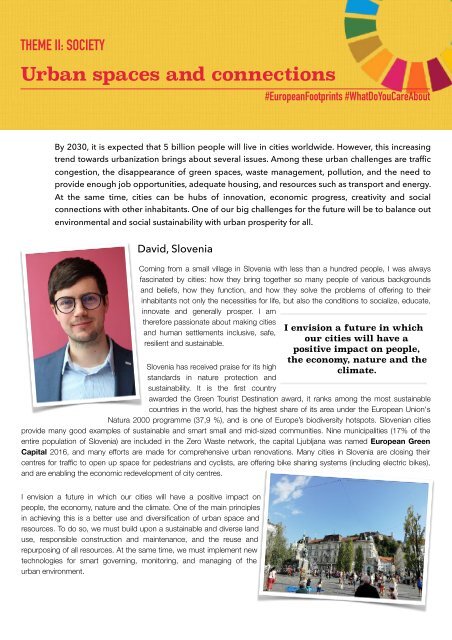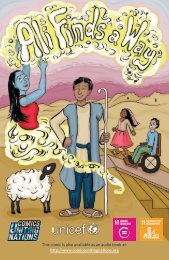Stories For A Sustainable Future
A teaching tool to be used in classrooms, addressing 13-18 year old students created by European Footprints Initiative. The storybook can be used as a whole, as it presents a general introduction on the SDGs, as well as thematically.
A teaching tool to be used in classrooms, addressing 13-18 year old students created by European Footprints Initiative. The storybook can be used as a whole, as it presents a general introduction on the SDGs, as well as thematically.
Create successful ePaper yourself
Turn your PDF publications into a flip-book with our unique Google optimized e-Paper software.
THEME II: SOCIETY<br />
Urban spaces and connections<br />
#EuropeanFootprints #WhatDoYouCareAbout<br />
By 2030, it is expected that 5 billion people will live in cities worldwide. However, this increasing<br />
trend towards urbanization brings about several issues. Among these urban challenges are traffic<br />
congestion, the disappearance of green spaces, waste management, pollution, and the need to<br />
provide enough job opportunities, adequate housing, and resources such as transport and energy.<br />
At the same time, cities can be hubs of innovation, economic progress, creativity and social<br />
connections with other inhabitants. One of our big challenges for the future will be to balance out<br />
environmental and social sustainability with urban prosperity for all.<br />
David, Slovenia<br />
Coming from a small village in Slovenia with less than a hundred people, I was always<br />
fascinated by cities: how they bring together so many people of various backgrounds<br />
and beliefs, how they function, and how they solve the problems of offering to their<br />
inhabitants not only the necessities for life, but also the conditions to socialize, educate,<br />
innovate and generally prosper. I am<br />
therefore passionate about making cities<br />
and human settlements inclusive, safe,<br />
resilient and sustainable.<br />
Slovenia has received praise for its high<br />
standards in nature protection and<br />
sustainability. It is the first country<br />
I envision a future in which<br />
our cities will have a<br />
positive impact on people,<br />
the economy, nature and the<br />
climate.<br />
awarded the Green Tourist Destination award, it ranks among the most sustainable<br />
countries in the world, has the highest share of its area under the European Union's<br />
Natura 2000 programme (37,9 %), and is one of Europe’s biodiversity hotspots. Slovenian cities<br />
provide many good examples of sustainable and smart small and mid-sized communities. Nine municipalities (17% of the<br />
entire population of Slovenia) are included in the Zero Waste network, the capital Ljubljana was named European Green<br />
Capital 2016, and many efforts are made for comprehensive urban renovations. Many cities in Slovenia are closing their<br />
centres for traffic to open up space for pedestrians and cyclists, are offering bike sharing systems (including electric bikes),<br />
and are enabling the economic redevelopment of city centres.<br />
I envision a future in which our cities will have a positive impact on<br />
people, the economy, nature and the climate. One of the main principles<br />
in achieving this is a better use and diversification of urban space and<br />
resources. To do so, we must build upon a sustainable and diverse land<br />
use, responsible construction and maintenance, and the reuse and<br />
repurposing of all resources. At the same time, we must implement new<br />
technologies for smart governing, monitoring, and managing of the<br />
urban environment.
















